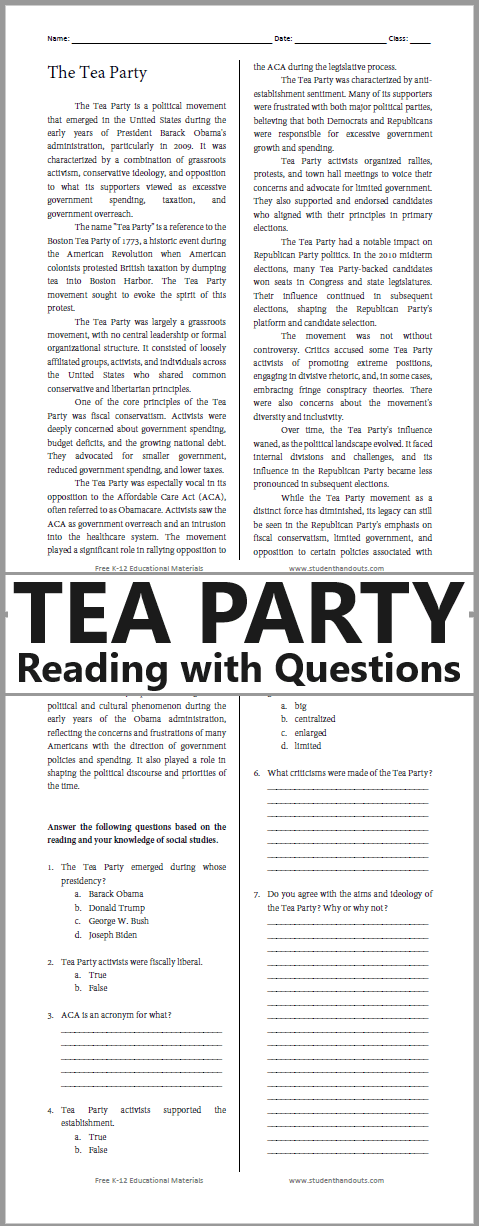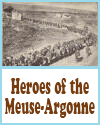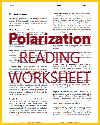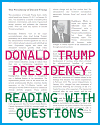| Tea Party Reading with Questions |
|---|
| www.studenthandouts.com ↣ U.S. History ↣ Polarization ↣ Polarization Worksheets |
The Tea Party was a political movement that emerged in the United States during the early years of President Barack Obama's administration, particularly in 2009. It was characterized by a combination of grassroots activism, conservative ideology, and opposition to what its supporters viewed as excessive government spending, taxation, and government overreach. The name "Tea Party" is a reference to the Boston Tea Party of 1773, a historic event during the American Revolution when American colonists protested British taxation by dumping tea into Boston Harbor. The Tea Party movement sought to evoke the spirit of this protest.
The name "Tea Party" is a reference to the Boston Tea Party of 1773, a historic event during the American Revolution when American colonists protested British taxation by dumping tea into Boston Harbor. The Tea Party movement sought to evoke the spirit of this protest.The Tea Party was largely a grassroots movement, with no central leadership or formal organizational structure. It consisted of loosely affiliated groups, activists, and individuals across the United States who shared common conservative and libertarian principles. One of the core principles of the Tea Party was fiscal conservatism. Activists were deeply concerned about government spending, budget deficits, and the growing national debt. They advocated for smaller government, reduced government spending, and lower taxes. The Tea Party was especially vocal in its opposition to the Affordable Care Act (ACA), often referred to as Obamacare. Activists saw the ACA as government overreach and an intrusion into the healthcare system. The movement played a significant role in rallying opposition to the ACA during the legislative process. The Tea Party was characterized by anti-establishment sentiment. Many of its supporters were frustrated with both major political parties, believing that both Democrats and Republicans were responsible for excessive government growth and spending. Tea Party activists organized rallies, protests, and town hall meetings to voice their concerns and advocate for limited government. They also supported and endorsed candidates who aligned with their principles in primary elections. The Tea Party had a notable impact on Republican Party politics. In the 2010 midterm elections, many Tea Party-backed candidates won seats in Congress and state legislatures. Their influence continued in subsequent elections, shaping the Republican Party's platform and candidate selection. The movement was not without controversy. Critics accused some Tea Party activists of promoting extreme positions, engaging in divisive rhetoric, and, in some cases, embracing fringe conspiracy theories. There were also concerns about the movement's diversity and inclusivity. Over time, the Tea Party's influence waned, as the political landscape evolved. It faced internal divisions and challenges, and its influence in the Republican Party became less pronounced in subsequent elections. While the Tea Party movement as a distinct force has diminished, its legacy can still be seen in the Republican Party's emphasis on fiscal conservatism, limited government, and opposition to certain policies associated with progressive governance. The Tea Party represented a significant political and cultural phenomenon during the early years of the Obama administration, reflecting the concerns and frustrations of many Americans with the direction of government policies and spending. It also played a role in shaping the political discourse and priorities of the time. Answer the following questions based on the reading and your knowledge of social studies. 1. The Tea Party emerged during whose presidency? a. Barack Obama 2. Tea Party activists were fiscally liberal. b. False 3. ACA is an acronym for what? Affordable Care Act (a.k.a. Obamacare) 4. Tea Party activists supported the establishment. b. False 5. Tea Party activists advocated for _________ government. d. limited 6. What criticisms were made of the Tea Party? Promoting extreme positions, engaging in divisive rhetoric, embracing fringe conspiracy theories, not being diverse and inclusive. 7. Do you agree with the aims and ideology of the Tea Party? Why or why not? Answers will vary. Click here to print. Answers are above. |
 |  |  |  |  |  |








